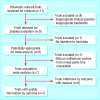Rates of caesarean section and instrumental vaginal delivery in nulliparous women after low concentration epidural infusions or opioid analgesia: systematic review
- PMID: 15169744
- PMCID: PMC421779
- DOI: 10.1136/bmj.38097.590810.7C
Rates of caesarean section and instrumental vaginal delivery in nulliparous women after low concentration epidural infusions or opioid analgesia: systematic review
Abstract
Objective: To compare the effects of low concentration epidural infusions of bupivacaine with parenteral opioid analgesia on rates of caesarean section and instrumental vaginal delivery in nulliparous women.
Data sources: Medline, Embase, the Cochrane controlled trials register, and handsearching of the International Journal of Obstetric Anesthesia.
Study selection: Randomised controlled trials comparing low concentration epidural infusions with parenteral opioids.
Data synthesis: Seven trials fulfilled the inclusion criteria for meta-analysis. Epidural analgesia does not seem to be associated with an increased risk of caesarean section (odds ratio 1.03, 95% confidence interval 0.71 to 1.48) but may be associated with an increased risk of instrumental vaginal delivery (2.11, 0.95 to 4.65). Epidural analgesia was associated with a longer second stage of labour (weighted mean difference 15.2 minutes, 2.1 to 28.2 minutes). More women randomised to receive epidural analgesia had adequate pain relief, with fewer changing to parenteral opioids than vice versa (odds ratio 0.1, 0.05 to 0.22).
Conclusions: Epidural analgesia using low concentration infusions of bupivacaine is unlikely to increase the risk of caesarean section but may increase the risk of instrumental vaginal delivery. Although women receiving epidural analgesia had a longer second stage of labour, they had better pain relief.
Figures



Comment in
-
Good news is often ignored.BMJ. 2004 Jul 31;329(7460):293. doi: 10.1136/bmj.329.7460.293. BMJ. 2004. PMID: 15284172 Free PMC article. No abstract available.
References
-
- Hawkins JL, Gibbs CP, Orleans M, Martin-Salvaj G, Beaty B. Obstetric anesthesia work force survey, 1981 versus 1992. Anesthesiology 1997;87: 135-43. - PubMed
-
- Hawkins JL, Koonin LM, Palmer SK, Gibbs CP. Anesthesia-related deaths during obstetric delivery in the United States, 1979-1990. Anesthesiology 1997;86: 277-84. - PubMed
-
- Chestnut DH. Anesthesia and maternal mortality. Anesthesiology 1997;86: 273-6. - PubMed
-
- Roberts CL, Algert CS, Douglas I, Tracy SK, Peat B. Trends in labour and birth interventions among low-risk women in New South Wales. Aust NZ J Obstet Gynaecol 2002;42: 176-81. - PubMed
